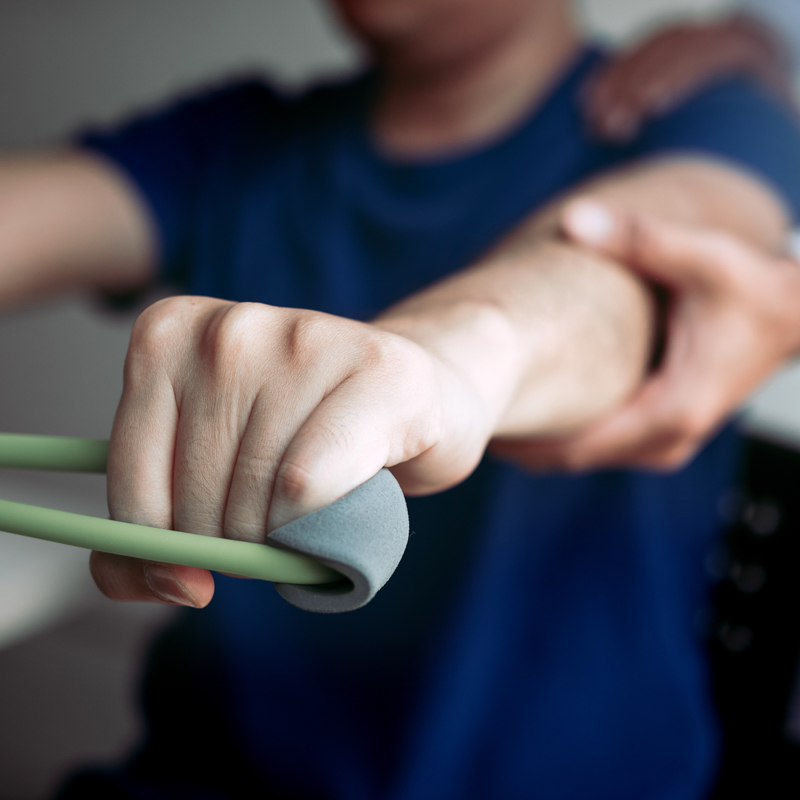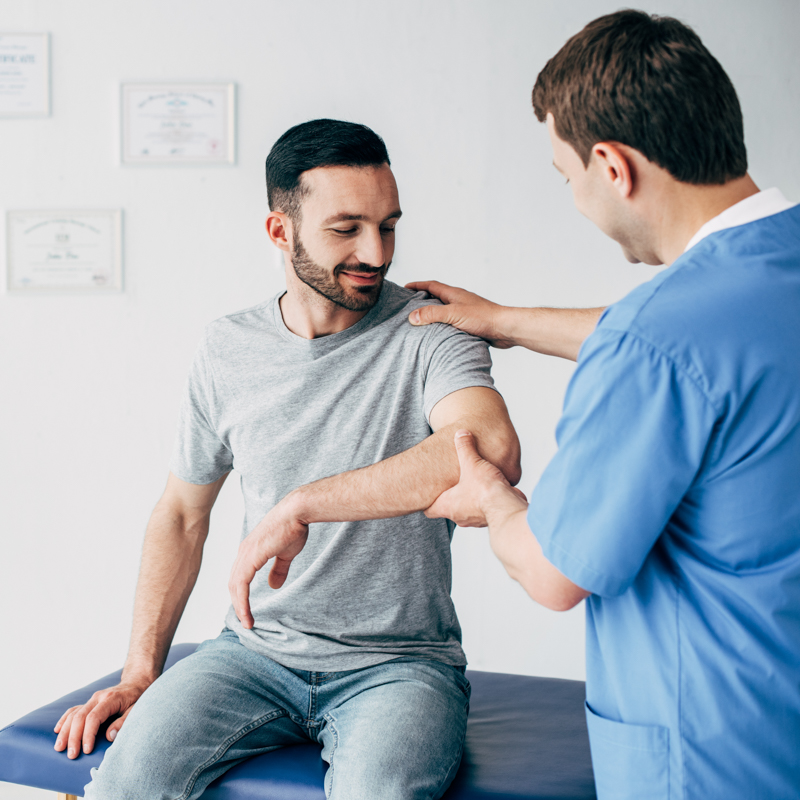Causes of shoulder problems
Shoulder pain and problems are common. Shoulder problems can be caused by injuries and sudden (acute) or long-lasting (chronic) inflammation of the shoulder joint. The shoulder is a complex joint that has a lot of mobility. This ability to move also increases the chances that it can be injured.
“Your shoulder has a tremendous range of motion. It’s actually the most mobile joint in your body,” said Dr. Lance LeClere, an orthopedic surgeon with Vanderbilt Orthopaedics. “Because of that, it’s also more likely to get hurt or become unstable.”
The shoulder is made up of several layers, including bones, joints, ligaments, tendons and muscles. Because the ball of the upper arm is larger than the socket of the shoulder, it is at risk of injury. The shoulder joint is supported by soft tissues — muscles, tendons and ligaments. They are also subject to injury, overuse and degeneration.
Progressive diseases that break down tissues in the body over time may also play a role in shoulder problems. Or they may cause pain that travels along nerves to the shoulder.
Common causes of shoulder problems include:
Dislocation. The shoulder joint is the most commonly dislocated major joint of the body. This is often caused by a strong force that separates the shoulder joint’s ball from the joint’s socket. The ball is the top rounded part of the upper arm bone (humerus). The socket is called the glenoid.
Separation. The acromioclavicular (AC) joint becomes separated when the ligaments attached to the collarbone (clavicle) are torn, or partly torn, away from the shoulder blade (scapula). Shoulder separation may be caused by a strong blow to the shoulder or a fall.
Impingement syndrome. This is caused by the excessive squeezing or rubbing of the rotator cuff and shoulder blade. The pain is from an inflamed bursa (lubricating sac) over the rotator cuff. Or it may be due to inflammation of the rotator cuff tendons. The cause could also be calcium deposits in tendons because of wear and tear. Impingement syndrome can lead to a torn rotator cuff.
Rotator cuff tear. A rotator cuff tear involves one or more rotator cuff tendons becoming inflamed and torn from overuse, aging, a fall on an outstretched hand, or a collision.
Bursitis. Bursitis often occurs when tendonitis and impingement syndrome cause inflammation of the bursa sac that protects the shoulder.
Tendinosis. Tendinosis of the shoulder occurs when the rotator cuff or biceps tendon becomes worn out and inflamed. This is often a result of being pinched by nearby tissues. The injury may vary from mild inflammation to most of the rotator cuff. When the rotator cuff tendon becomes inflamed and thickened, it may become trapped under the acromion.
Adhesive capsulitis (frozen shoulder). This condition is often caused by an injury that leads to lack of use because of pain. Not enough use may cause inflammation and scar tissue to grow between the joint surfaces, which limits motion even more. There is also a lack of synovial fluid to lubricate the gap between the arm bone and socket. This fluid normally helps the shoulder joint to move.
Fracture. A fracture is a partial or total crack or break through a bone. It often occurs due to an impact injury.
Arthritis. The cartilage in the shoulder can wear out and become thin, just like in other joints such as the knee or hip. Shoulder arthritis can progress over time and is usually not associated with an injury. Shoulder arthritis can lead to pain, stiffness and decreased function.
Explore more about shoulder pain

A guide to osteoarthritis
What to know if you’re dealing with stiff, painful joints.

3 reasons for chronic shoulder pain
These painful shoulder problems bother many people. Here’s how to get some relief.

To strengthen shoulder muscles, try this exercise
Shoulder presses are a basic exercise that can relieve pain and improve function.
Symptoms of shoulder problems
“You might experience shoulder pain in just one spot. But it can also spread to areas around the shoulder or down the upper arm,” LeClere said. “The type of pain and where you feel it will depend on the nature of your injury and exactly where the problem is.”
A rotator cuff injury, for instance, will often cause pain in the top or outside of the shoulder. The pain gets worse when you raise your arm or try to lift an object over your head. Rotator cuff pain can be severe. It can make even simple tasks impossible and wake you up at night.
If you have shoulder instability, you may feel your shoulder slip or clunk in and out of place. Pain can be associated with instability episodes, but the shoulder is often not in pain in between instability episodes. The symptoms of a dislocated shoulder include intense pain, inability to move the joint, a visibly out-of-place shoulder and swelling or bruising. The dislocation can cause numbness, tingling or weakness near the injury or down your arm. A dislocated shoulder needs immediate medical care.
If shoulder pain is caused by inflammation, such as bursitis, it may feel stiff, achy and hurt more when you move it. If you have significant stiffness, you may have a frozen shoulder.
How shoulder problems are diagnosed
A health care provider will ask you about your health history. They will give you a physical exam.
“During a physical exam, your provider is checking to see how your shoulder moves in various directions, what causes pain, what your shoulder strength is, where the pain is in the shoulder and the level of joint stability,” LeClere said. “It is helpful to know what activities increase your pain, and what makes the shoulder feel better. Every piece of information you share helps us understand your shoulder problem and how we can best help you.”
You may have tests, such as:
- X-ray. Your doctor will get X-rays in order to look at the bones and joints of the shoulder. Fractures, arthritis and improper alignment are often best seen on X-rays.
- Magnetic resonance imaging (MRI). These are detailed, computer-generated images from a series of magnetic impulses. There is no radiation involved, but some medical conditions or implants may prevent you from being able to get an MRI. This kind of imaging is done at an advanced imaging center and usually takes about 30 minutes. It can be very helpful at looking at soft tissues such as muscles, tendons, ligaments and cartilage.
- Computerized tomography (CT) scan. This imaging test uses a series of X-rays and a computer to provide additional details with a 3-D effect. This kind of scan shows detailed images of any part of the body, including the bones, muscles, fat and organs. The images they produce are more detailed than general X-rays.
- Electromyogram. This is a test to evaluate nerve and muscle function.
- Ultrasound. This imaging test uses high-frequency sound waves to create an internal image, and can be helpful when looking at specific areas of the shoulder, such as rotator cuff tendons.
- Lab tests. These can help to figure out if other problems may be the cause.
- Arthroscopy. This is a minimally invasive procedure used for joint conditions. This procedure uses a small lighted optic tube that is put into the joint through a small incision. Images of the inside of the joint are projected onto a screen. Arthroscopy can be helpful in diagnosing shoulder conditions because of the ability to look directly inside the joint. Many shoulder surgeries can now be performed with arthroscopy, including rotator cuff repair, labral repairs, biceps repairs, treatment of AC joint arthritis and more.
How shoulder problems are treated
The goals of treatment are to ease pain and restore your shoulder to normal function.
“Our primary goal is to return to you back to full function and activity, with a pain-free and strong shoulder,” LeClere said. “Thankfully, for many shoulder conditions this can be achieved without surgery. However, if surgical treatment is required, then there are excellent techniques for achieving our goals, with excellent outcomes.”
Rest and changing how you do some daily activities are common recommendations right after an injury. Physical therapy and medications such as ibuprofen, naproxen and other nonsteroidal anti-inflammatory medicines may be prescribed. A home exercise program or physical therapy may be recommended, and your provider might recommend an injection of anti-inflammatory steroids. If those treatments fail or are not advised for your injury or condition, your provider may discuss surgical options.




